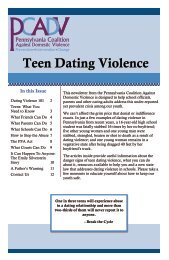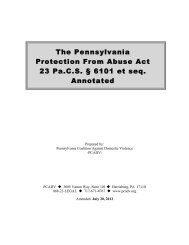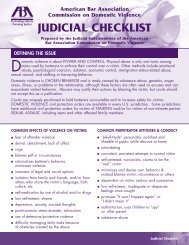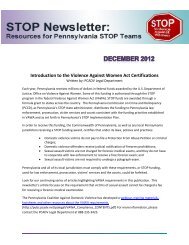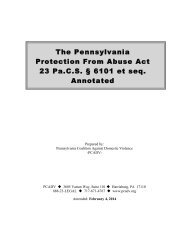Toolkit with Report Form - Pennsylvania Coalition Against Domestic ...
Toolkit with Report Form - Pennsylvania Coalition Against Domestic ...
Toolkit with Report Form - Pennsylvania Coalition Against Domestic ...
You also want an ePaper? Increase the reach of your titles
YUMPU automatically turns print PDFs into web optimized ePapers that Google loves.
Section five<br />
Bringing in Other Individuals<br />
Hearing from an outside expert, who is<br />
objective in their presentation yet sensitive to<br />
the emotions of the group, is often helpful.<br />
Factual information can help many people<br />
to reach a point of acceptance. Addressing<br />
lingering questions and putting the critical<br />
incident in its proper context can help<br />
reestablish a sense of safety, security and<br />
control so that staff can move forward in their<br />
daily lives.<br />
Examples:<br />
◗ In the case of a building fire, a local<br />
fire inspector or fire services professional<br />
can talk about the origins of the fire, how<br />
the fire may have affected the safety of<br />
the building and what could or should be<br />
done differently in the future if a similar<br />
event occurs.<br />
◗ Medical personnel can attend staff,<br />
volunteer, client and community meetings<br />
to address questions about the manner of<br />
death or serious injury that continues to<br />
resonate <strong>with</strong> those affected by the critical<br />
incident.<br />
Getting the Word Out<br />
During critical incident times ongoing<br />
communication <strong>with</strong> the community is<br />
crucial. It is important to document all inhouse<br />
communications and to provide<br />
written media statements. Media statements<br />
should include information that reassures the<br />
community that services will resume upon<br />
stabilization of the program and informs<br />
them how to access services in the interim.<br />
Any disruption in services should be<br />
reported IMMEDIATELY to PCADV<br />
<strong>with</strong> the information requested on the<br />
<strong>Domestic</strong> Violence Critical Incident<br />
Response and Management <strong>Report</strong><br />
<strong>Form</strong>. A plan to maintain services<br />
until the program is stabilized must<br />
be identified.<br />
When A Decision To<br />
Close Has Been Made<br />
If it is necessary for your program to close,<br />
provide enough staffing so advocates are<br />
available to respond to those clients who<br />
are not yet aware of the closing. Staff<br />
should remain available until word of the<br />
closing is communicated throughout the<br />
community. Consider how to reach those<br />
current clients who may not have access to<br />
any media sources.<br />
Review your program’s confidentiality<br />
policy. Questions about confidentiality<br />
issues should be immediately directed<br />
to the PCADV Legal Department.<br />
page 28<br />
When Crisis Strikes | <strong>Pennsylvania</strong> <strong>Coalition</strong> <strong>Against</strong> <strong>Domestic</strong> Violence | 2012



